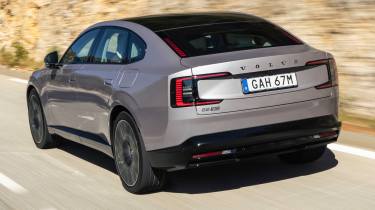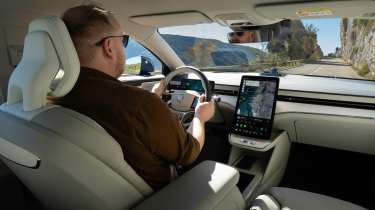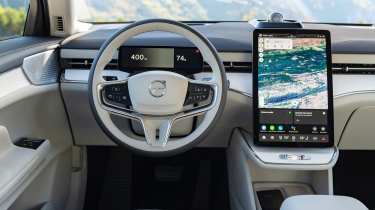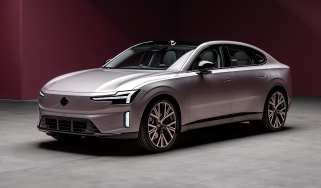New Volvo ES90 2025 review: electric exec fails to live up to its huge price tag
The new Volvo ES90 has plenty of plus points, but the Polestar 4 does it it all and more for significantly less money

Verdict
For those who cover long distances, the Volvo ES90 offers an incredibly quiet and spacious cabin, huge range figures, true ultra-rapid charging abilities, good ride comfort and a sophisticated Scandinavian vibe. Yet to us, it feels like it lacks thought in certain places, particularly when it comes to technology and the rear cabin. The near-£70k starting price is a little steep, too, especially when the Polestar 4 features an exceptional, more modern-feeling and more practical interior, plus a similarly long range, but is available for considerably less money.
That’s right, Volvo doesn’t just make SUVs! The new Volvo ES90 is strutting into town to take on highly impressive, all-electric executive saloons like the BMW i5 and Audi A6 e-tron, as well as the cutting-edge Polestar 4.
The ES90 is obviously not your traditional three-box saloon. Volvo says it’s been designed with the “refined elegance of a sedan, the adaptability of a fastback” – whatever that means – and “the spacious interior and higher ground clearance associated with an SUV”.
It shares a lot with Volvo’s seven-seat EX90, starting with the sleek front end design that incorporates the same headlights and pixelated ‘Thor’s Hammer’ daytime running lights. That thing on the roof is not a taxi beacon, it’s a LiDAR stack; one of the numerous sensors and cameras dotted around the car that feeds the safety and driver-assistance tech.
Used - available now

2022 Mercedes
EQA
50,730 milesAutomaticElectric
Cash £17,900
2023 Mercedes
A-Class
33,289 milesAutomaticPetrol1.3L
Cash £18,600
2020 Jaguar
F-Pace
35,782 milesAutomaticDiesel2.0L
Cash £20,200
2024 Audi
A3 Sportback
40,740 milesAutomaticPetrol1.4L
Cash £19,300The cabin is almost indistinguishable from the EX90’s as well, inheriting the same slim nine-inch driver’s display, head-up display and floating 14.5-inch portrait touchscreen. The Google-based infotainment system is responsible for controlling everything on this car, including opening the glovebox, while the only physical control is a scroll wheel for the volume located below the touchscreen.
The dashboard is largely the same too, featuring a combination of real wood and Volvo’s sustainable Nordico leather alternative – partly made from pine oil sourced from Swedish and Finnish forests. The main difference is the centre console design, which is lower and more open than the EX90’s tall centre tunnel.
Our test car featured the light-grey ‘Dawn’ interior colour scheme, with ash wood on the dashboard and two-tone hand-stitched steering wheel. This would be our choice simply because it makes the cabin feel more airy than the black ‘Charcoal’ or beige ‘Cardamom’ designs.
This interior looks very classy and the materials feel nice to the touch. Although if you start to proding around you’ll notice the leather-like trim, like on the doors, is just a very thin layer covering up the hard plastic beneath. There’s also a fair amount of plastic dotted around, but at least it has a soft matte finish.
Both the screens are bright and clear, and we like that the driver’s display doesn’t overwhelm you with information. Various Google apps like Google Maps come built-in, which are excellent as always, and the 25-speaker Bowers and Wilkins stereo you get in higher-spec models is simply magnificent. It’s powerful, exceptionally clear and creates an immersive surround-sound stage. The new Abbey Road Studios mode is also a fun novelty that will entertain the audiophiles.
Unfortunately, the touchscreen in our test car was occasionally laggy. We couldn’t connect to Apple CarPlay at all, and Volvo’s latest infotainment system still isn’t as easy to use as we would like. For one thing, the small icons are hard to tap while driving, and there is a multitude of menus you have to sift through to change literally any setting. Google’s voice assistant can help with certain things, but even so, for a company obsessed with safety, forcing the driver to take their eyes off the road so much to use the touchscreen seems rather baffling.
There is the so-called ‘contextual bar’ that runs along the lower part of the touchscreen, which is supposed to learn the functions you use most frequently and offer shortcuts. We can only assume it takes a while to learn the driver’s habits, because the one in our car kept offering us a way to quickly change the drive mode – despite the fact options are limited to ‘standard’ and ‘off-road’, which our route around Monaco didn’t call for at any point.
Another major annoyance is with the pitiful rear visibility. You get a sliver of a rear windscreen in the ES90, which you can barely see out of if the middle seat headrest is in place, and definitely not if there’s a person sitting there. We’re not the biggest proponents of digital rear-view mirrors, like you get a Polestar 4, however this is one time that it would have been incredibly helpful to fit one.
The ES90 is a full five metres long and has a wheelbase of 3.1 metres, meaning it’s larger than the Volvo S90 it replaces. As you’d hope, there is a lot of space in this car, especially for rear-seat passengers who will be able to stretch out. Even six-feet-tall adults have headroom to spare, and the panoramic glass roof floods the cabin with light.
As is often the case in electric cars, the floor in the rear is very high because of the battery pack underneath, meaning if passengers have long legs they don’t get much under thigh support. A solution we’ve seen in other executive EVs is carving out part of the battery to create what Porsche calls 'foot garages’, but sadly the ES90 doesn’t have anything like that.
Rather than the letterbox-style tailgate of a traditional saloon, the ES90 has a proper hatchback, so it’s easy to throw stuff into the 424-litre boot. It’s a good size and shape, and there’s just enough space under the floor for the charging cables. Admittedly, all of its rivals offer more luggage capacity, particularly the Polestar 4 which you can cram 526 litres worth of stuff into.
There is a 22-litre ‘frunk’ under the Volvo’s bonnet, which is something the BMW i5 doesn’t have. But because of the unusual curved shape of the tray inside, you can barely fit anything in it. A backpack at most, maybe.
Much like Audi’s A6 e-tron, rather than offering a long range or fast charging, the ES90 delivers on both fronts. Twin Motor versions are powered by a huge 106kWh battery that offers up to 435 miles of range, while a maximum charging speed of up to 350kW (base cars top out at 310kW) allows for a 10 to 80 per cent top up in just over 20 minutes. You get them with 443bhp or 671bhp – the more potent version will do 0-62mph in four seconds flat.
This isn’t a car for doing quarter-mile drag races though, so most buyers will probably stick with the Single Motor set-up we drove. Even the base Single Motor set-up, which gets a slightly smaller 92kWh battery, can cover up to 400 miles on a single charge.
The 328bhp rear-mounted motor is good for 0-62mph in under seven seconds. Getting up to motorway speeds is easy, but it feels like the car has run out of puff when you try to overtake. Nevertheless, the ES90 feels really at home on the motorway, where you can appreciate how incredibly quiet it is inside. The only intrusion we noticed was a touch of road noise, though that may have something to do with the 22-inch rims on our test car.
It took us a while to get to grips with the one-pedal driving in the ES90. You have to be very delicate with what feels like a very heavy throttle in order to drive smoothly: a bit too much pressure and the car can bolt forward, while easing off too quickly would see it suddenly slow down. But after a while we got the hang of it.
There’s also a one-pedal auto mode which is helpful if your journey involves a mixture of town, country and motorway driving because the car won’t slow when you lift off unless it detects a vehicle in front of you. Ideal for those who like to ‘set it and forget it’.
You could hustle the ES90 on a country road if you’re late for a meeting or picking up your in-laws from the airport. But ultimately, this is a big, heavy car clearly not bred for this sort of thing. Even with the steering in the firm setting that adds more weight, it’s still about as vague as a politician on a hot-button topic, and unsurprisingly it leans in the corners.
The ES90 starts from £69,760, with the entry-level model offering a huge range, plus the array of displays you see here, a 360-degree 3D camera system, energy-saving heat pump and 20-inch wheels. But the Polestar 4 is available for nearly £10,000 less, is well-equipped and offers 385 miles of range. The Audi A6 e-tron also starts from about £62,000, with a similar 384-mile range.
If you want all the luxuries and tech Volvo can offer on this car, upgrading from Plus to Ultra trim raises the price to nearly £80,000. A top-of-the-range Twin Motor model will set you back nearly £90k.
If you're tempted by the new Volvo ES90 and don't want to wait, why not check out the EX90 SUV instead? You can buy a new Volvo EX90 for just over £80,000 through our Buy a Car service.
| Model: | Volvo ES90 Ultra Single Motor Extended Range |
| Price: | £79,160 |
| Powertrain: | 92kWh battery, 1x e-motor |
| Power/torque: | 328bhp/480Nm |
| Transmission: | Single-speed automatic, rear-wheel drive |
| 0-62mph: | 6.6 seconds |
| Top speed: | 112mph |
| Range: | 400 miles |
| Max. charging: | 310kW (10-80% in 22 mins) |
| Size (L/W/H): | 5,000/1,942/1,546mm |
| On sale: | Now |




